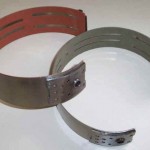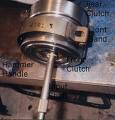- bands-transmission
- drum & band
An automatic transmission band is a steel strap with friction material bonded to the inside surface. One end of the band is anchored against the transmission case while the other end is connected to a servo. At the appropriate time hydraulic oil is sent to the servo under pressure to tighten the band around the drum to stop the drum from turning.
Simply put, a band wrapped around a drum becomes a brake, so to speak. When it is applied or squeezed, it stops the drums rotation. In fact, before hydraulic brakes were invented, brakes worked on the same premise, except they were operated manually. Essentially we can call this a ‘brake band’ since it stops drum rotation when it is squeezed tight around the drum.
When the valve body provides a signal to the band apply mechanism called a servo assembly, the band is slowly closed around the drum. This clamping of the band around the drum stops drum movement, spinning up the proper planetary gear, therefore providing the gear range being selected by the valve body.
Most transmissions use anywhere from one to three bands. The only automatic transmission that uses no bands is a TF-604. When a band wears out, it is most likely time to rebuild your transmission, get a pre-tested used transmission or even a new transmission.
Not to worry though, with proper maintenance and friendly driving habits, bands rarely wear out prematurely. However all transmissions from GotTransmissions.com are equipped with new factory original bands.
Read more of our GotTransmissions.com blog for diagnosis articles, repair articles and unusual transmission information. You may be surprised.




